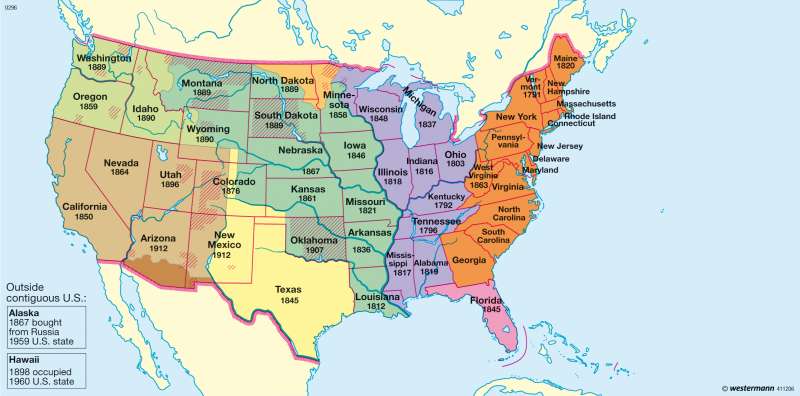Political development
U.S.A. - Past and present
978-3-14-100790-9 | Page 136 | Ill. 2

Information
The colonisation history of North America was accompanied by numerous military conflicts between the colonial powers and their Indian allies. The last great war was the French and Indian War. In the Peace of Paris (1763), France lost all its North American territories to Great Britain. Only Louisiana, west of the Mississippi, remained Spanish and New Orleans French.Independance
The American independence movement arose after the British Parliament decided to raise taxes, fees and tariffs in its North American colonies through the Sugar Act (1764), the Stamp Duty Act (1765) and later the Townshend Act (1768). America's answer — "no taxation without representation" (as the Americans had no representation in the British Parliament) was accompanied by protests and the boycott of British goods. In 1770, an armed confrontation, the "Boston Massacre", resulted in five deaths. The British Parliament adopted punitive measures against which, a closed resistance formed in the colonies. In Philadelphia, 56 delegates met with the First Continental Congress. After they had declared the illegality of the British tax laws and adopted a general trade boycott, the American War of Independence broke out in 1775. George Washington took command of the armed forces. In 1776, the 13 founding states declared their independence, and consequently, a constitution drawn up and a state established.
Westward Expansion
The expansion of the state followed an Act of Parliament in 1787 which was decided by Congress.. New states were to be formed and simultaneously admitted to the Union. The first of which was Vermont, Kentucky, Tennessee and Ohio. Other states followed along the municipal border (changing frontier). At the same time, Indian reservations were built inland.
From the mid-19th century, the development of the western Pacific coast evolved with the establishment of settlements. In 1850, part of the State of California, followed by Oregon and Nevada, became members of the Federation, followed later by the states of the Midwest and South between 1889—1912.
Constitution
After the constitution was ratified by the member states, it came into force in March 1789. It formed the United States of America as the first modern constitutional state. Valid to this day, the Constitution is based on the principles of separation of powers, of popular sovereignty and the federal principle. The Congress as a legislature (the legislature) is made up of Parliament, the House of Representatives and the states representation in the Senate. It shall decide all questions of national defence and foreign policy, the duties and taxes on coins, weights and measures. The President (executive power as the executive) is elected by popular vote by electors. He appoints the officials and ensures the implementation of Congress decisions. He has a suspensive veto, which can be overruled by Congress by a two thirds majority. He is also the supreme commander of the US military. The judiciary (the law responsible for force) is exercised by a Supreme Court, which supervises the constitution and the law.
K. Lückemeier, H. D. Laux, G. Thieme; Ü: C. Fleming




